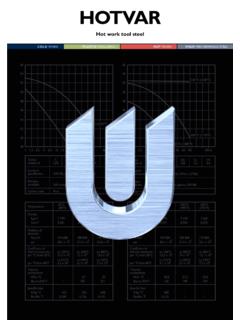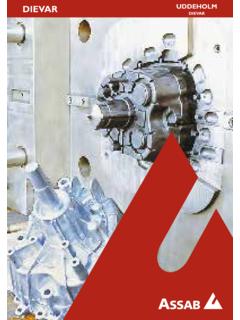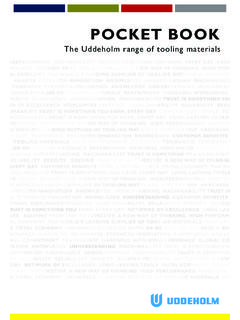Transcription of DIEVAR | Premium Hot Work Tool Steel | Data Sheet
1 DIEVAR Premium hot work tool steel2 DIEVARThis information is based on our present state of knowledge and isintended to provide general notes on our products and their uses. It shouldnot therefore be construed as a warranty of specific properties of theproducts described or a warranty for fitness for a particular is a high performance chromium-molyb-denum-vanadium alloyed hot work tool Steel whichoffers an unparalleled resistance to heat checking,gross cracking, hot wear and plastic is characterized by: Excellent toughness and ductility in alldirections Good temper resistance Good high temperature strength Excellent hardenability Good dimensional stability throughout heattreatment and coating TOOLING PERFORMANCED ievar is a proprietary, Premium hot work tool steeldeveloped by Uddeholm.
2 It is manufactured utilizingthe very latest in production and refining tech-niques. The DIEVAR technology has yielded a die steelwith the ultimate resistance to heat checking, grosscracking, hot wear and plastic deformation. Theunique properties profile for DIEVAR makes it thebest choice for die casting, forging and work applicationsDievar is certified to a minimum, averageCharpy V-notch impact toughness of 14 ft-lbs(19 J) and a minimum unnotched impact tough-ness of 220 ft-lbs (300 J) per testing proceduredefined by NADCA #207 97 and #207 high levels of toughness and ductility yieldthe optimum resistance to gross cracking and heatchecking practical terms, heat checking is the most com-mon failure mechanism for the majority of hot worktooling.
3 DIEVAR s superior ductility ( approxima-tively two times that of Premium H13) yields thehighest possible level of heat checking , DIEVAR s outstanding toughness andhardenability can be used to achieve further gainsin heat checking resistance, if gross cracking is not afactor with competitive die steels, by allowing ahigher working hardness to be used (+2 HRC) with-out risking gross cracking failure. Higher workinghardnesses are known to impede the initiation ofthermal fatigue of the dominant failure mechanism; be itheat checking, gross cracking, hot wear or plasticdeformation, DIEVAR offers the potential for signifi-cant improvements in tooling plantTypeCr-Mo-V Hot Work SteelStandardspecificationNoneDeliveryco nditionSoft annealed to HBColor codeGrey/yellow4 DIEVAR 210 390 570 750 930 1110 1290 F 100 200 300 400 500 600 700 C Testing temperaturePropertiesThe reported properties are representative ofsamples which have been taken from the center ofan 8" x 24" (203 x 610 mm) bar.
4 Unless otherwiseindicated all specimens have been hardened at1875 F (1025 C), quenched in oil and temperedtwice at 1160 F (625 C) for two hours; yielding aworking hardness of 44 46 PROPERTIESData at room and elevated F750 F1110 F(20 C)(400 C)(600 C)Density, 8007 7007 600 Modulus of elasticitypsi x 106 x x 106 MPa210 000180 000145 000 Coefficient ofthermal expansionper F from 68 F x 10 6 x 10 6per C from 20 C x 10 x 10 6 ThermalconductivityBtu in/(ft2h F) 216223W/m C 31 32 Charpy V-notch impact toughness at elevatedtemperature, typical transverse J102887358443015 MPa2902000261180023216002031400174120014 51000116 800 87 600 58 400 29 200 0 Tensile properties at elevated average impact properties for DIEVAR (inaccordance with testing procedures outlined byNADCA #207 97 and #207 2003).
5 Testing techniqueMinimum averageCharpy V Notch14 ft-lbsRoom temperature(19 J)Charpy V Notch50 ft-lbs500 F (260 C) (70 J)Unnotched 220 ft-lbs (300 J)MECHANICAL PROPERTIEST ensile properties at room temperature, shorttransverse 44 HRC48 HRC52 HRCT ensilestrength, Rm 1480 MPa 1640 MPa 1900 MPa214 000 psi237 000 psi275 000 psiYieldstrength, 1210 MPa 1380 MPa 1560 MPa175 000 psi200 000 psi226 000 psiElongation, A5 13 % 13 % %Reductionof area, Z 55 % 55 % 52 %ksiRm, is the material of choice for high demand diecasting, forging and extrusion tooling. Tools which are large and/or complex Tools which will be subjected to high servicetemperature and pressures Tools which will undergo severe thermalcycling in serviceDievar should also be considered in cold work appli-cations where high toughness is a requirement.
6 120 210 300 390 480 570 660 750 840 F 50 100 150 200 250 300 350 400 450 C Testing temperature1401201008060402045 HRC47 HRC50 HRCI mpact energy %100 90 80 70 60 50 40 30 20 A5, ZZ5 DIEVARH ardness, HRCT emper resistanceThe specimens have been hardened and temperedto 45 HRC and then held at different temperaturesfrom 1 to 100 1 10 100 Time, hHeat treatment generalrecommendationsSOFT ANNEALINGP rotect the Steel and heat through to 1560 F(850 C). Then cool in furnace at 20 F (10 C) perhour to 1110 F (600 C), then freely in RELIEVINGA fter rough machining the tool should be heatedthrough to 1200 F (650 C), holding time 2 slowly to 930 F (500 C), then freely in temperature: 1110 1650 F (600 900 C).
7 Normally a minimum of two preheats, thefirst in the 1110 1200 F (600 650 C) range, andthe second in the 1510 1560 F (820 850 C) temperature: 1830 1885 F (1000 1030 C), normally 1875 F (1025 C). For large crosssections, 1850 F (1010 C) is timeHardness before C Fminutestempering100018303052 2 HRC102518753055 2 HRCS oaking time = time at hardening temperature after the tool isfully heated the tool against decarburization andoxidation during , grain size and retained austenite asfunctions of austenitizing temperature1086605856545250 GrainsizeASTMH ardnessGrain sizeRetained austenite 1815 1830 1850 1870 1885 1905 1920 F 990 1000 1010 1020 1030 1040 1050 C Austenitizing temperatureRetained austenite %420 1110 F(600 C) 1200 F (650 C)1020 F(550 C)Hardness, HRC504540353025 930 F(500 C)
8 Oil pan coverDie casting die for aluminum oil pan cover6 DIEVAR1 Air cooling ofbars, mm101001 00010 000100 000 Seconds1101001 temperature 1025 CHolding time 30 optimal working hardness and tempering tem-perature for a die are very dependent upon the spe-cific application. As a general rule, if heat checkingis the primary concern and there is no history ofgross cracking for a given Premium H13 die, then anincrease in working hardness of approximately 2 HRC is recommended for the DIEVAR tool. If grosscracking is a concern for the given project then acomparable working hardness should be tempering temperature for a given workinghardness should be selected by referencing the be-low tempering graph.
9 Temper minimum of twotimes with intermediate cooling to room tempera-ture after each tempering operation. Holding timeat temperature minimum 2 hours. Check workinghardness between tempers and adjust temperatureaccordingly to maintain the specified working hard-ness. A stress temper is not temper in the range of 930 1020 F(500 550 C) to avoid temper a general rule, quench rates should be as rapidas possible. Accelerated quench rates are requiredto optimize tool properties specifically with regardsto toughness and resistance to gross cracking. Ifhigher working hardness are to be investigated,with the goal of improved heat checking resistance,it is imperative that the minimum recommendedquench rates are allowed.
10 However, risk of excessivedistortion and cracking must be mediaThe quenching media should be capable of creatinga fully hardened microstructure ( martensite)throughout the die, whenever possible. As a rule,transformation products such as carbides, pearliteand bainite should be avoided. Minimum quenchrates for DIEVAR are defined by the CCT diagram. Theseverity of the quenching media will depend upondie size and geometry. Possible quenching mediainclude but are not limited to: high speed gas/circulating atmosphere. Vacuum ( high speed gas with sufficient positivepressure). An interrupted quench at 610 840 F(320 450 C) is recommended where distortioncontrol and quench cracking are a concern.




